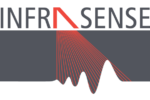Infrared Thermography
The detection of bridge deck delaminations using Infrared Thermography is carried out according to ASTM D 4788 – 03 using high-resolution, distance-triggered infrared and video cameras operated from an elevated platform attached to a survey vehicle. The infrared camera is capable of capturing a full lane width of data per driving pass, has a frame rate of 60 frames per second, and thermal sensitivity of fewer than 0.1 degrees C. All data collection is carried out at normal driving speeds, and no closures are required. In some cases, infrared data can also be collected using fixed-wing aircraft (Aerial Infrared). This method of data collection is preferred over the utilization of drones because it is more productive, cost-effective, and accurate. Since beginning this form of data collection with our first project in 2017, Infrasense has surveyed over 2500 bridge decks across Wisconsin, Rhode Island, Indiana, North Dakota, Alaska, Texas, and Minnesota.
Infrared cameras are available in “cooled” and “uncooled” models that are optimized for different applications. “Cooled” cameras use cryocoolers integrated into the image sensor in order to reduce thermally-induced noise to levels below those of the recording signal. This technology allows the camera to record extremely narrow temperature differences, target small thermal targets, and record at high frame rates for crisp images during high-speed data collection, perfect for Infrasense’s high-speed vehicle-based surveys. The compromise is that these cameras are heavier and more expensive; uncooled cameras use standard microbolometer technology, which allows the camera to be lightweight and more affordable. Infrasense uses microbolometer infrared cameras for Aerial IR and slow-speed vehicle-mounted surveys.
The infrared data is analyzed to quantify and map deck delamination and/or overlay debonding. White blotchy areas on the IR images are “hot spots” where the surface temperature is higher, indicating thermal barriers caused by delaminations. For decks with overlays, these “hot spots” can be attributed to either debonding of the overlay or delamination at the rebar level.
Thermal composite images are created for each deck using Infrasense’s proprietary software, and the delaminated and debonded areas that appear in each image are outlined with a cursor. These outlined areas are then quantified and used to create final plan area maps.




